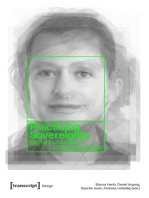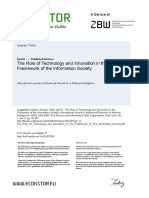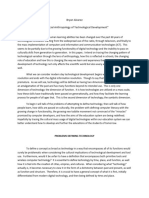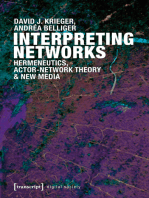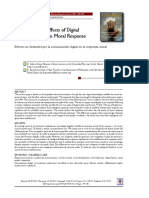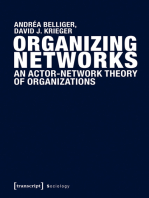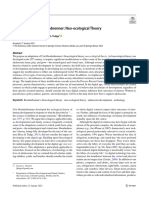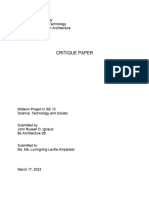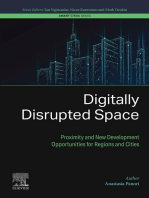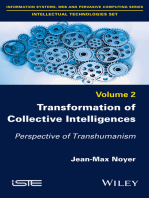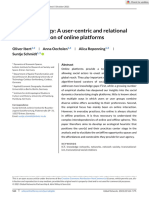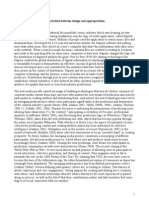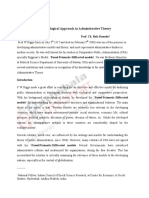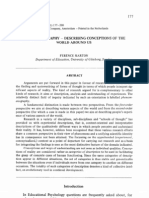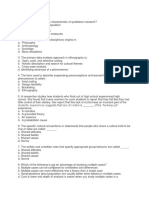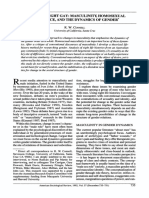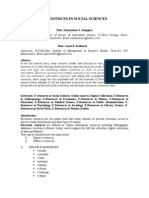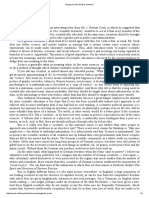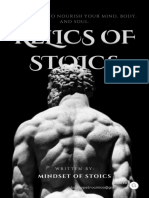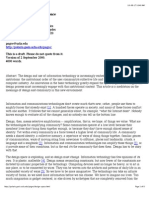Professional Documents
Culture Documents
Appropriation of Information and Communication Technology by Kinese Internet Users The Paradox of Uses of Digital Social Networks
Original Title
Copyright
Available Formats
Share this document
Did you find this document useful?
Is this content inappropriate?
Report this DocumentCopyright:
Available Formats
Appropriation of Information and Communication Technology by Kinese Internet Users The Paradox of Uses of Digital Social Networks
Copyright:
Available Formats
Volume 11, Issue 3, March 2023 International Journal of Innovative Science and Research Technology
ISSN No:-2456-2165
Appropriation of Information and Communication
Technology by Kinese Internet Users: The Paradox of
Uses of Digital Social Networks
Gabriel ALONGE ONOLOKE
Graduate of Advanced Studies in Information and Communication Sciences from the University of Kinshasa
Master in Criminal Law and Criminology from the same University Teaching assistant
Abstract:- The appropriation of information and work towards the analysis of the appropriation process
communication technologies has led Internet users in (Hatchuel, 1996; Ciborra, 2000; Orlikowski, 2000; Lorino,
general and particularly those living in the city of 2002; De Vaujany, 2005, J. Zetlaoui-Leger, 2012, Lino
Kinshasa to deliberately live a paradox. This forces them Pungi 2013). From then on, many theories have been
to breathe in a digital universe that is both satisfying and interested in appropriation (from the sociology of ICT use,
disturbing. Through the analysis of a case of usurpation which analyzes by domain (work, domestic life, citizenship,
of the digital identity of a victim on the social network consumption, leisure, etc.) to the management of
Facebook, we demonstrate how the situation of paradox appropriation of management tools (which analyzes through
in the use of digital technologies can push users, through the tools used). Finally, many concepts have been grafted
bricolage, to an evolving spring of use and creativity onto the appropriation concept (adoption, acceptance,
assimilation, integration, diffusion, infusion, structuring, in
I. INTRODUCTION a more collective perspective) 2. Appropriation seems to be
the sum of all these concepts, at the risk of appearing as
The revolution of information and communication their common denominator.
technologies is today based on the ideal of progress, thus
provoking the upheaval of societies, including the The "paradox", on the other hand, is understood as an
Congolese ones as a whole, and particularly that of opposition that contains or seems to contain a logical
Kinshasa. Thus, this progress is undoubtedly supported by contradiction, or a reasoning that, although without apparent
the development of computer science and the Internet fault, ends in an absurdity, or a situation that contradicts the
network. common intuition3. It appears as the fact of affirming or
denying a thing and it’s opposite.
Considered as the most active technologies, the
Information and Communication Technology (ICT) have Within the framework of the appropriation of the ICT
been of great contribution, as no other type of ancient or and their uses, the paradoxality appears at the same time as
antediluvian technology had been able to do it, becoming the result of a contradictory process satisfying and not
not only among the types of the most profitable satisfying, of intelligence and moral idiocy; of responsibility
technologies, but also the most accessible. Moreover, they and irresponsibility of disposition and use. Using social
opened the prologue of the famous "digital era", considering networks, the special framework of our study, the
the advances that were made around them, and that appropriation of this digital tool could lead to a use that is at
increasingly stimulated the importance of digital. It is with the same time adequate and threatening. In this optic, Milad
reference to this revolution that our reflection focuses on the Douehi affirms that "digital technologies are at the same
appropriation of the said technologies from the point of time innocence and limitless potential, they also become the
view of their use, by Internet users of social networks in place of cunning, of a technique- induced miscegenation, in
general, and those using Facebook in particular, considered short a technical wound'4.
as the most used social network in the Congolese capital.
From the above, leaving aside the sphere of absurdity,
Thus, so many opinions on appropriation accepted in paradoxes can be used as positive opportunities to push the
the field of communication, find their foundation in the individual who is subjected to them to choose a way out of
Cultural Studies1. Indeed, many authors hav oriented their the problem as it had been formulated. This illustrates the
principle of paradoxical interventions in which the paradox
1
Cultural studies is a research current of Anglophone origin
2
at the crossroads of sociology, cultural anthropology, J.F., TRINQUECOSTE, " regards croisés sur le processus
philosophy, ethnology, literature, mediology, arts, etc. d'appropriation des technologies de l'information et de la
With a transdisciplinary aim, they present themselves as communication ", in revue de Mangement et Avenir,
an "anti¬discipline" with a strong critical dimension, Mangement Erospective Ed, Volume 5, N°45, 2011, pp.
particularly with regard to the relations between cultures 175-178.
3
and power. Transgressing the academic culture, cultural www.techno-Science.net, paradox, accessed July 22, 2021
studies propose a "transversal" approach to popular, at 1:26 PM.
4
minority, protest cultures, etc. (on M. DOUEHI, Qu'est-ce que le numérique, PUF, Paris,
https://fr.wikipedia.org/wiki/tudes_culturelles). 2013, p.16.
IJISRT23MAR1058 www.ijisrt.com 2000
Volume 11, Issue 3, March 2023 International Journal of Innovative Science and Research Technology
ISSN No:-2456-2165
forces a reframing of the perception of the situation. The following disturbances in his environment. His
paradoxical intervention is the specificity of a therapist: the representations will guide his action with the tool and this
latter provokes a cognitive tension which pushes the action will update his representations. It is a recursive
individual to make a qualitative leap to reframe. Such a process. The result of this process is a "stability"
process constitutes a spring of creativity5. recovered following this phase of disturbance in the
individual's cognitive structure. In the case of the
Given this dual reality of paradox, we resorted to the appropriation of a tool, it is manifested by a recurrence in
analysis of digital identity theft on the social network terms of use and is characterized by a minimal cognitive
Facebook, asking how paradox can become an opportunity and technical mastery of the technical device in order to
for creativity in the evolution of technological use? use it. In the case of the appropriation of knowledge, we
speak of an internalization of knowledge.
The first point of our reflection outlines the
The process of constructing meaning: here,
generalities on appropriation, use and paradox. The second
appropriation is the process by which an individual
point analyzes the paradoxical appropriation of the social
invests meanings and values in the use of the tool. It is the
network Facebook by Kinshasa's Internet users, using a
process by which an individual will give meaning to a
concrete case of digital identity usurpation. Finally, the third
tool. The designer of an object has prescribed uses and the
point presents the virtue of the paradox that leads to
user, through a process of appropriation, will construct his
creativity and technological evolution.
own use of it. The result of the process is characterized by
II. APPROPRIATION, USE AND PARADOX a difference in usage between those imagined by the
designers and those actually used by the users, and by
A. On ownership different usages between users in the same context.
The concept of "appropriation" comes from the Latin The process of forming practices: appropriation is the
"appropriare", which means "the action of making one's process by which the organization's routines will be built
own, of appropriating". It takes into account two notions: on on the basis of the properties of the technology. The
the one hand, the idea of appropriation of a thing for a mechanism (at the organizational level) is the following:
defined use, and on the other hand, the action aiming at the organization has social structures. The developer of
making something own (exclusive, personal, individual). the technology incorporates the social structures of the
That is to say that the individual fully enjoys the object, and organization into the technology. The technology has
holds the exclusive right of disposal and use. social structures (structural characteristics and spirit). Its
introduction will disrupt the stability of the organization.
As for Josiane Jouet, she finds that appropriation is From several cycles of structuring (action of the users
another act that runs through the problems of domestic and with the technology), there is production of social
professional uses and that we find analyzed in its subjective structures of the organization with a technology in use.
and collective dimension. He adds, "appropriation is a The organization thus finds a stability.
process: it is the act of constituting a self'6 . In the
construction of the use, it is also based on processes which Nelly Massard thus provides an integral definition that
testify of a stake in the personal identity and the social allows for the cognitive, relational and praxeological factors
identity of the individual. The appropriation proceeds then of appropriation to be taken into account. With Serge
from a double affirmation: of the singularity and of the Proulx, apart from the fact of first having access to the
belonging which connects to the social body7. technical device (a prerequisite), four conditions are
required for the appropriation of a technique to take place:
From the above, we can understand from these Technical and cognitive mastery of the artifact;
definitions that appropriation is an individual process whose Significant integration of the technical object in the daily
expression is manifested at the social level. In addition, it is practice of the user;
important to emphasize with Nelly Massard8 that The repeated use of this technology opens up creative
appropriation covers three processes, each of which gives possibilities (actions that generate novelty in social
rise to a result that she has named "state" of appropriation: practice);
The cognitive process: appropriation is the process that Finally, at a more properly collective level, social
allows an individual to rebalance his cognitive structure appropriation implies that users are adequately
represented in the establishment of public policies and at
the same time taken into account in the innovation
5
Y. GIORDANO, Le paradoxe : Penser et gérer autrement processes (industrial production and commercial
les organisations, Ed. Perret, V. & Josserand and Ellipses, distribution)9.
Paris, 2003, p.14.
6
J., JOUËT, " Retour critique sur la sociologie des usages ", Indeed, the identification of the specific characteristics
in Réseaux, n°100, vol.2, Univ-Paris- Est, La découverte, of a dominant technology allows to approach its
February 2000, pp. 487-521. consequences on the culture and the functioning of the
7
Idem, pp.487-521. society. Besides, the appropriation is the power to use, to
8
N., MASSARD, Revisiting the notion of appropriation: personalize the use of the object to purposes that seem the
For an application to the case of ERP, 14th Colloquium of
the Association Informatique et de management, Marrakech,
9
Morocco, June 10-12, 2009. S., PROULX, op.cit. pp. 7-20.
IJISRT23MAR1058 www.ijisrt.com 2001
Volume 11, Issue 3, March 2023 International Journal of Innovative Science and Research Technology
ISSN No:-2456-2165
most advantageous, independently of the primordial destiny home and the outside world". The user shows himself to
of the object 10. The user appropriates the technical object by others with the technology, he tells them about it"13.
personalizing to other purposes that the manufacturer
destines to his subject. In this order of ideas, Serge Proulx In a logic of dialogical interaction between the user
underlines that "it is the way by which an individual and the technical device, Serge Proulx thinks that the
acquires, masters, transforms or translates the codes, the interventions that users can make directly on the devices
protocols, the know-how necessary to deal correctly with constituted in the perspective of making a use of it more in
the technical tool"11. accordance with what they wish. Thus, four cases are
highlighted:
In the context of information and communication Displacement: the user modifies the spectrum of uses
technologies,ThisSince 1975, informational technologies without introducing major modifications in the technical
have been mobilized in the in-depth reorganization of device;
industrial societies. The technical key which allowed the Adaptation: the user modifies the device to fit his use
takeoff of the informational technologies resides in the without changing the original function of the object;
digitalization of the signal which made possible the Extension: elements are added to the device to enrich the
technological convergence between the big domains of the list of functions.
computing, the telecommunications and the audio-visual. Hijacking: the user uses the device for a purpose that has
Digital technologies penetrate all economic sectors nothing to do with its intended use14 .
(primary, secondary, tertiary). Digital technologies
participate in the transformation of the modes of production, B. On the use
consumption, communication, circulation of knowledge and The Robert dictionary of sociology gives two main
acquisition of knowledge. A recent significant event was the meanings to the notion of usage. Firstly, this notion refers to
advent of the Internet phenomenon, in particular the general the "social practice that seniority or frequency makes normal
public diffusion of this innovation with the implementation in a given culture", a meaning close to the term of mores,
of the World Wide Web and the commercialization of the the practices being here "lived as natural". Secondly, the
network of networks in 1995. At the dawn of the 21st authors of the sociology dictionary specify that use refers to
century, the trend is towards the universal adoption of the IP "the use of an object, natural or symbolic, for particular
(Internet Protocol) standard in technical telecommunication purposes". We are thinking here of the social uses of a good,
protocols, which is causing a generalization of the presence an instrument, an object in order to highlight "the complex
of the Internet on a global scale12. cultural meanings of these conducts of everyday life" 15. It is
certainly this second meaning that is used in the context of
In the same perspective, Silverstone in his work ICT usage studies.
analyzes the domestication of ICT in everyday life in four
phases: "appropriation, objectification, incorporation and One of the first uses of the notion of use in media
conversion. sociology comes from the American functionalist current of
The appropriation: the technique leaves the world of the "uses and gratifications", close to the Columbia School. In
goods, the individual or the household makes it his own. the 1960s and 1970s, researchers wanted to distance
He must acquire a certain amount of knowledge and themselves from the dominant unitary thinking that
know-how to master the object; described media action too exclusively in terms of effects
Objectification: the new technique finds with ("what the media do to people"). They seek to abandon this
objectification a material location in the familiar mediacentrism. They propose a shift of the research
environment which allows it to be used. Often a special program towards the uses ("what people do with the
differentiation appears between what is individual or media"). They thus postulate that audience members
shared, adult or adolescent, male or female; "actively" use the media to derive specific satisfactions that
Incorporation: the technical object is used and meet psychological or psychosociological needs. For
incorporated into the routines of daily life. This process is example, environmental radio listening is described as a
accompanied by a constant work of differentiation from "compensatory use" that fills the psychological gap of
the other technical objects and of particularization; loneliness. This fiercely functionalist perspective was
The conversion: corresponds to the process during which rightly accused by researchers from other currents of being
the ICT in use "establishes new relations between the reduced to a psychologism of uses16.
13
P., FLICHY ; " Technique, usage et représentations ", in
10
KAGAMA, "L'appropriation des TIC et de Réseaux, n° 148-149, February 2008, Univ-Paris- Est, La
développement," in découverte, pp. 147-174.
www.er.URGAN.Ca/NOBE/D3.61/DEVELOP, (Accessed
March 17, 2023 at 11:55 AM). 14
PROULX, op.cit., pp. 7-20.
11
S., PROULX, quoted by Florence MILLERAND et alii, 15
Id.
La culture technique dans l'appropriation cognitive des TIC. 16
B. PHILIPPE and S. PROULX, L'explosion de la
Une étude des usages du courrier électronique, Paris, Acte communication. Introduction aux théories et aux pratiques
du colloque international, ICUST, 2001, p.408. de la communication, La Découverte, Paris, 2006, available
12
PROULX, op.cit., pp. 7-20. at www.sergeproulex.info.
IJISRT23MAR1058 www.ijisrt.com 2002
Volume 11, Issue 3, March 2023 International Journal of Innovative Science and Research Technology
ISSN No:-2456-2165
In 1980, a French historian Michel de Certeau paradoxical definitions, still called "semantic antinomies",
published, with members of his research team, his famous "epistemological paradoxes" (Ramsay, 1926) or "paradoxes
book entitled "The Invention of the Everyday", in which he concerning propositions". The paradoxes of infinity, such as
recognizes from the outset the capacity of individuals for Zeno's, and the visual paradoxes 20 can be related to them.
autonomy and freedom. His approach consists in grasping
the mechanisms by which individuals create themselves Fortuitously, we can think that the paradox often
autonomously as subjects in certain key domains of cultural appears as an amiable game of the mind. It appears in
creativity of ordinary people, such as consumption, housing contradictory statements, where a cleverly concealed riddle
or reading17. has no other purpose than to surprise the recipient. This
relegates it to the rank of a meaningless distraction.
With his detailed descriptions of the "arts of doing"
and the "ways of doing" of users, Michel de Certeau seeks Indeed, in philosophical thought, the paradox is an
to highlight the operations of the "practitioners" by which object of study in itself, which questions our modes of
they socially mark a gap in a given provided by reasoning and puts our theories to the test, not only in
technocracies and cultural industries through their practices. formal systems, but in many fields of our knowledge. From
Ordinary people are capable of creativity, he asserts: they this point of view, its study belongs to logic and to the
are able to invent their own way of navigating the philosophy of knowledge. Insofar as we consider the
constructed universes of the cultural industries (through contents of conscious mental states as propositions, the
tricks, bricolages, poaching or detour). By setting in motion paradox takes place between cognition and truth as well as
a subtle game of tactics (assuring them the control by time) in what links truth and propositions. Therefore, we attribute
inscribing itself in false against the strategies of the big to it another, less known role: the persistence of the logical
technocracies (having the control on the space), the problem in which it participates leads, according to certain
practitioners show a moral and political resistance which hypotheses, to personality disorders. Fortunately, if used
opposes the offer of cultural products by the industries of properly in an appropriate context, it would become an
the consumption. effective factor in recovery21 .
From all that has been said above, Proulx draws a In the field of communication, Gregory Bateson,
satisfactory reflection of social uses that goes beyond the through his work in epistemology of communication,
individual framework, which is the result of Pronovost's developed the pragmatic perspective of paradox. Later, Paul
work. Thus, "social uses are defined as the patterns of use Watzlawick and his colleagues from Palo Alto, will spread
of individuals or groups of individuals (strata, categories, his writings, insisting on the inhibiting role of paradoxes in
classes) that prove to be relatively stabilized over a more or human communication. If in linguistic pragmatics, the
less long historical period, on the scale of larger social paradox is rather studied for itself, in communication
groups (groups, communities, societies, civilizations)"18 . pragmatics, the paradox is interesting for its effects on the
individuals in interaction. In order for a possible
C. The paradox communicational paradox to appear, it is necessary to
The concept "paradoxical" comes from "Para: next to, interpret interaction situations from the following premises:
hence "contrary", and doxa: "opinion"", forming the Greek the unit of analysis is the meaningful interaction for the
adjective paradoxos, substantivized into paradoxon and then individuals who participate in it. All communication has two
taken up by the Latins. Its plural paradoxa gave Cicero the levels: the first transmits information about facts, opinions
title of a treatise on the surprising propositions of the Stoic (it is a "clue"). The second, simultaneously, expresses
doctrine. Borrowed from Latin, it designates, by extension, something about the relationship established between the
'"what goes against the commonly accepted opinion". Above interlocutors (it is an "order"). Usually, if the double
all of "logical nature", the paradox is defined from its dimension of the communication does not appear, it is
characteristic property: to rest on true premises and to lead, because the two levels are "congruent". But if a
by a valid reasoning, to contradictory conclusions19 . contradiction occurs between message and meta-message,
the superposition of the two levels appears. For example,
Watzlawick distinguishes between antinomies, declaring "I am delighted' with a tense smile or "I am
semantic paradoxes and pragmatic paradoxes. Antinomies, listening to you" while looking out of the window will
or logical paradoxes, appear in formal logical- mathematical create discomfort in the interlocutor: there is a
systems and provide the theoretical framework for the superimposition of two antinomic messages with the
analysis of other paradoxes. Linguistic paradoxes (Peano, obligation to take both into account at the same time22. A
1906), or semantic paradoxes (Chwistek, 1937) are paradoxical injunction is presented as an order which
contains in itself a contradiction in such a way that the one
17
S. PROULX, op.cit., pp.7-20. to whom it is intended is unable to answer it in a satisfactory
way. Communication is paradoxical when it contains two
18 messages that qualify each other in a conflicting way.
S. PROULX, op.cit., pp.7-20.
19
J.C, KELLER, Le paradoxe dans la communication :
implications épistémologiques et usages thérapeutiques,
20
Thèse de doctorat, Université Paul Verlaine de Metz, École Id.
21
Doctorale Perspectives Interculturelles : Écrits, Médias, J.C, KELLER, op.cit. p. 42 to 45.
22
Espaces, Sociétés, 2018, p.42. Idem, p.9.
IJISRT23MAR1058 www.ijisrt.com 2003
Volume 11, Issue 3, March 2023 International Journal of Innovative Science and Research Technology
ISSN No:-2456-2165
The Palo Alto researchers have highlighted the fact many authors in organization who are interested in
that we can be subjected to paradoxical injunctions, which situations of emergency, conflict or change have done. In
force some people to take time off from their tasks. these situations, context and relationship have an important
psychological value: emergency decisions are made in a
The double bind, a very pernicious form of context of strong uncertainty about their validity; conflicts
paradoxical injunction, has been studied extensively by are costly for many stakeholders; changes disrupt the
Bateson, particularly in the psychiatric context. The established and generate anxiety.
elements that make up a double bind can be described as
follows: III. THE PARADOX OF THE APPROPRIATION
Two or more people are involved in an intense OF DIGITAL SOCIAL NETWORKS BY
relationship which, for at least one of them, has great KINESE INTERNET USERS
psychological value. The situations characteristic of
intense relationships are multiple: couple relationships, A. Context of use
parent-child relationships, material and psychological Referring to the work of A.S. COLLARD and J.
dependence, loyalty to a cause, a norm, an ideology, JAQUES26on the appropriation of digital social networks,
professional commitment, etc.; but also in light of all the attempted definitions provided
In such an emotionally charged context, a message is above, the appropriation of social networks by Kinshasa's
delivered and structured in such a way that : users involves four elements: usage practices, digital
it asserts something; literacy, social representation, and DIY.
he affirms something about his own affirmation;
Usage practices
these two statements are mutually exclusive.
Usage practices refer to the implementation of skills,
Finally, the receiver of the message is prevented from
experience and resources in the use of digital social
leaving the framework set by this message, either by
networks by users. Chaudiron and Ihadjadene define these
meta-communication (which would constitute
practices as "a set of devices, formal or informal sources,
unacceptable criticism) or by withdrawal (if his position
tools, and cognitive skills that are effectively mobilized by
of power forbids criticism)23.
an individual or a group of individuals in the various
That the message appears to be meaningless is not the situations of using digital social networks27. These are ways
most important thing. It has, on the other hand, a much more of doing things that are individually, socially and culturally
formidable pragmatic reality: one cannot not react to it, but established. The analysis of informational practices implies
one cannot react to it in an adequate (non-paradoxical) way to be interested in the contextual factors of the situations in
either, since the message is itself paradoxical. Consequently, which these practices see the light of day, broken down into
an individual caught in a double constraint is in a very specific actions, and drawing their meaning with regard to
uncomfortable situation and can: more global projects.
feel "punished" (or at least guilty) if he detects the double While practice defines the actions carried out by the
constraint; user, the term usage is reserved to designate the interactions
be considered "crazy" if he insinuates that there is a between users and the devices. From the above, by
discrepancy between what he sees and what he "should" observing the uses of digital social networks by Kinshasa's
see24 . users in order to inform and be informed, to entertain, to
In the long run, only three outcomes are possible, which communicate with their relatives, to assert their identity and
depend largely on the power system in place: to build their e-reputation, etc., it is worth noting that they
resentment and withdrawal if the recipient(s) are in a end up with the possibility of relationships to be built
position of weakness, with the establishment of a "never- between the said users and the technical object, but also
ending game" in which the protagonists find themselves with the possibilities of uses offered by the affordances
trapped in a game that they themselves have created and perceived by them in order to appropriate the social
which they help to reproduce; networks. In other words, the appropriation of social
conflict, if the balance of power is more equal; networks by Kinshasa's users is a function of the affective
end of the relation (the receiver "unmasks" the paradox character, the competence and the capacity to use the digital
and puts an end to the relation). It is clear that many device, which offers the inherent facilities to inform; to
situations make this last solution impossible and therefore entertain; to build one's identity, one's reputation, etc.,
put the receiver in a literally "crazy" situation because he taking into account Kinshasa's social and cultural practices.
is in a "low" position that forbids him to meta-
communicate25.
We can see that a communicative representation of 26
A.S. COLLARD and J. JAQUES, " Appropriation des
paradoxes can be interesting to mobilize for contexts réseaux sociaux numériques et compétences médiatique ", in
broader than the couple or the family. This is precisely what CRIDS (Centre de recherche en information, Droit et
Société), speech on the LUDOVIA conférence, N°12, Ax-
les-Thermes (France) from 24 to 26 August 2015, pp. 1-11
23 27
GIORDANO, op.cit, p.10. .CHAUDIRON, M. IHADJADENE, De la recherche de
24
Idem, p.11. l'information aux pratiques informationnelles ", in Études de
25
Ibid. Communication, numéro 35, 2010, pp. 13-30
IJISRT23MAR1058 www.ijisrt.com 2004
Volume 11, Issue 3, March 2023 International Journal of Innovative Science and Research Technology
ISSN No:-2456-2165
Thus, contemporary social practices of publishing time, which creates the paradox of use. In this respect, Bulea
information, entertainment and identity construction place and Bronckart maintain that competence does not exist in
the sharing of personal information at the heart of the uses itself; it can only be understood in a situation, when the
of digital social networks, raising questions about the way in individual is confronted with concrete situations in which he
which this data is published and the way in which it brings or she takes action to achieve a goal32. It is motivated by a
into play the identities of users28 . These online publication goal, an expected result, which makes evaluation possible.
sites support self-expression but also different forms of The social dimension of competences is then translated by
sociability through which Kinshasa's Internet users organize the fact that their evaluation is deeply linked to the judgment
or accommodate the relationships they develop there. The of others33. The competent person is always competent for
observation of these practices among Kinshasa's users one or more "others" who recognize him as such. A
reveals forms of appropriation of digital social networks, competent person is therefore someone who will mobilize
highlighting an empowerment, i.e. the way in which they resources and take action to achieve the objective set in a
define their own uses. given situation and in a socially accepted way. In this sense,
competence is at the center of relationships of legitimacy
This empowerment is supported by the digital skills and recognition.
they can mobilize, skills that are manifested in the ability to
use digital social networks and manage relationships, to Social representations
organize the network, to evaluate the opportunity to publish Individuals are social beings, that is, they bring into
personal information, to entertain, etc. The autonomy of their representations the ideas, values and models they hold
users is a process of individual appropriation, but it is also from their groups or from the ideologies conveyed in
dependent on their social and cultural capital29, their society. Taking the form of reference systems, categories or
identities, their belonging, their perceptions, and the theories, social representations convey practices, images,
dispositions that structure their relationship to the world30 . opinions, attitudes, relating to an object such as an activity,
In particular, the appropriation of digital social networks by an event, a person, an idea34 , etc.
Kinshasa users projects social representations coming from
the social discourse conveyed by educational institutions, As a result, the appropriation of digital social networks
colleagues, friends, family members, the media, public by Kinshasa's users reflects the values of sharing and
meetings, etc. sociability, but also a way of looking at technically
instrumented relationships, as Jouet points out, "a form of
Digital Literacy technical rationality" 35 . It also includes norms such as the
Many authors have focused on the skills needed to deal respect of privacy, the respect of the integrity of the person36
with the challenges of digital social networks and have , etc. Through the sharing of values, norms, attitudes, the
proposed different models of digital literacy skills. These social representations define the individual and collective
proposals are mainly focused on skills related to mastering identity. Each "group expresses its contours and its identity
technical tools, adapting to their use and creating by the meanings with which it invests its representation"37.
functionalities related to their cultures and needs. From the
above, the appropriation of digital social networks by Thus, the practice of using digital social networks,
Kinshasa's users is a function of holding basic knowledge of through the Kinshasa social representations that users put
writing, reading, navigation and organization31. The city and on, participates in defining the identity of different Internet
province of Kinshasa is the largest agglomeration in the users, hence the bloggers, influencers, cybercriminals, etc.
DRC to have a higher number of digital alphabets, which
justifies the high number of users of social networks. 32
E., BULEA ; J.-P., BRONCKART " La saisie des
compétences dans l'interprétation de l'activité de travail ", in
Indeed, the appropriation of digital social networks by Bulletin Vals/Asla, number 84, 2006, pp.143-171.
Kinshasa's users can only be read through the evaluation of 33
The competent person is always competent for one or
the results of uses that are both good and bad at the same more "others" who recognize him/her as such. A competent
person is therefore someone who will mobilize resources
28
Y. ANDONOVA ; " Parcours réflexif de la problématique and take action to achieve a given objective in a given
des usages : une tentative de synthèse ", in Communication situation and in a socially accepted way. In this sense,
et organisation, numéro 25, 2004, on competence is at the center of relationships of legitimacy
http//doi.otg/10.4000/com.org.2960, quoted by A.S and recognition
34
COLLARD and J.JACQUES, op.cit, consulted on February D., JODELET " Représentation sociale : phénomène,
25, 2023 at 12h037'. concept et théorie ", from his book " Psychologie sociale "
29
H. BOURDELOIE, L'appropriation des dispositifs S.Moscovici, PUF, Paris, 1984, pp.363-384
35
d'écriture numérique translittératie et capitaux culturel et J., JOUËT, op.cit, pp.487-521.
36
social, in Etudes de communication, issue 38, 2012, pp.23- S., PROULX, " Trajectoires d'usages des technologies de
36. communication : les formes d'appropriation d'une culture
30
J. DENOUËL and F. GRANJON, Communiquer à l'ère numérique comme enjeu d'une société du savoir ", in
numérique. Regards croisés sur la sociologie des usages, Annales des télécommunications, numéro 57, 2002 ; pp.180-
Presses des mines, Paris, 2011, quoted by A.S. Collard and 189.
37
J.Jacques, op.cit. accessed on February 25, 2023 at 12h42'. D., JODELET, op.cit, pp.363-384.
31
Id.
IJISRT23MAR1058 www.ijisrt.com 2005
Volume 11, Issue 3, March 2023 International Journal of Innovative Science and Research Technology
ISSN No:-2456-2165
The social representations of Kinshasa finally orient the convey, to transform themselves in a dynamic way, leading
behaviors of the users of the digital social networks, they to new uses42.
define specific goals and procedures for what they carry out.
B. Analysis of the paradox
Do-it-yourself Our analysis sets in motion the case of identity theft on
The socio-technical relationship that binds Kinshasa's the social network Facebook, focusing on the content of the
users of digital social networks is built more by tactics than text and image of a stolen account of a young Congolese
by strategies, to use Michel de Certeau's terminology. state employee, in order to identify the emerging paradox of
Instead of strategically managing actions directed towards a use.
defined goal, of activating a rationality, the Kinshasa
Internet user seizes the possibilities, plays with what the Therefore, three sequences of images are highlighted:
device offers to turn them into opportunities. For the the first one presents the identity theft of the Internet user
cybercriminal Internet user, he will therefore rather take and the reactions that follow, coming from different friends,
advantage, at opportune moments, of the sociotechnical victims or observers of the scene. The second sequence
affordances perceived in his environment and combine them illustrates the replica of the owner of the usurped account
according to his needs, his expectations or his circumstantial and the efforts of the cybersecurity DIY that she provides to
motivations. secure it. The third sequence finally shows the pleasure of
using the social network Facebook of the Internet user; in
These combinations support forms of bricolage where spite of the damage suffered.
the elements of the technical and social environment are
resources that will be reinterpreted by the user to be adjusted Pictorial presentation of identity theft
to his activities, by successive approximations38. The It is about the identity theft of Mrs. Esther ASINDI,
bricolage of a Kinshasa Internet user is not an activity in Congolese subject of the public sector work. A
itself, but is grafted onto other activities such as, in this case, cybercriminal hacked her account, pretending to be her,
the commission of a crime, namely identity theft. presenting himself in a situation of extreme urgency and
contracting loans with the option of repayment with interest
The appropriation of digital social networks by within a short period of time, from his friends on the social
Kinshasa's Internet users takes shape through the network Facebook. He asks the poor victims to transfer the
development of these forms of bricolage. These DIY uses money to a phone number used for the circumstance, while
involve, while participating in their development, the morally castigating them that his usual numbers did not pass
various social representations that the user possesses and anymore.
imply a process of progressive internalization of skills39.
The appropriation results therefore from creative,
"disordered and active" learning40.
The forms of bricolage observed are supported at the
cognitive level by the combination of the different
representations present. Chaudiron and Ihadjadene evoke, at
the heart of informational practices, the tensions "between
mobilizable knowledge, immediate competences, habitus,
arts of doing, desires to act41, etc.
Among these elements in tension among Kinshasa's
Internet users are representations that give rise to a different
perception of the situation and their environment, that imply
different intentions and that guide action in a different way.
To overcome these tensions, Kinshasa's Internet users must
make adjustments, combine certain resources and develop
new representations that integrate the mobilized
representations in a new way. This process can also lead
social representations, and the norms and values they
38
M. GENSOLLEN, " Vers une société du bricolage
coopératif ? ", in PROULX S., GARCIA J. L., HEATON L.,
" La contribution en ligne. Pratiques participatives à l'ère du
capitalisme informnel ", in Presses de l'Université du
Québec, 2014, pp.33-48.
39
F. JAURREGUIBERRY, Proulx S. Usages et enjeux des
technologies de communication, Erès éditions, Paris, 2011.
42
40
Id. S.PROULX, op.cit, pp.180-189
41
A.S. COLLARD and J. JAQUES, op.cit, pp.1-11.
IJISRT23MAR1058 www.ijisrt.com 2006
Volume 11, Issue 3, March 2023 International Journal of Innovative Science and Research Technology
ISSN No:-2456-2165
SEQUENCE A
1 2 3
Source: our captures, with certified authorization of the victim of the usurped account
Above we have three different images: Mrs. ALINE (second victim), with the option of
The first image shows us two accounts of Mrs. Esther repayment with interest of 70% loan, that is to say
ESINDI. The account on top is a usurped identity and the 30,000FC, which will make a total of 80,000FC.
account on the bottom represents the real account of the The third image illustrates the detection of Mrs ALINE of
person. the usurping account, which immediately reports to Mrs
The second image illustrates the account of the usurped Esther whose account is usurped, the damage she is
identity that makes an urgent request for funds to the tune suffering.
of 50,000FC in the name and without the knowledge of
Mrs. Esther ASINDI (first victim), a request directed to
IJISRT23MAR1058 www.ijisrt.com 2007
Volume 11, Issue 3, March 2023 International Journal of Innovative Science and Research Technology
ISSN No:-2456-2165
SEQUENCE B
1 2
Source: our captures, with certified authorization of the victims
Above we have two different images: The second image shows us, by an individual tinkering,
The first image shows the indignant reaction of Mrs. the modification of the protection parameters against this
Esther ASINDI to her identity theft, issuing a warning to usurpation by reducing the number of seen of the friends
all her friends of the risk of money swindle that they risk to his publications. The victim directs his publications to a
by the usurper. small group.
IJISRT23MAR1058 www.ijisrt.com 2008
Volume 11, Issue 3, March 2023 International Journal of Innovative Science and Research Technology
ISSN No:-2456-2165
SEQUENCE C
1 2 3
Source : nos captures, avec autorisation certifiée des victimes
Above we have three images: As for the text, we note that we are in front of three
The first image in its upper part shows the updating and categories of interlocutors: the impersonator, the owner of
publication of the victim's private data after the theft of the impersonated account (first victim) and her friends
his digital identity. (second victims). In the first sequence of the
The second image illustrates the continuation of the communication, the impersonator enters in relation with the
publications of the daily activities of the victim, while friends of the first victim considered here as a third person
experiencing the satisfaction of using the digital social not yet acted in the Transmitter-Receiver relation. In the
network Facebook. second sequence of communication, the evolution of the
The third image shows the victim's publication keeping a communicative act puts the victim in relation with friends,
smile and finding pleasure in using Facebook. but also with the cyber public by the informative and
warning game. The common denominator triggering this
C. Analysis of textual and pictorial contents process is the criminal act of the usurper. The
communication here goes from the relation to the
Series A: commission and disclosure of the crime evolutionary systemic process, which puts in movement the
In the first series of images presented above, the first interlocutors that participate in the functioning of the
image shows us the presence of two accounts of the same processual and global digital system.
person, which allows us to detect identity theft by creating
an account identical to the victim's, but parallel in terms of Series B: the informative and protective gesture
the objectives pursued. Firstly, the second series of images has an informative
and protective character. The first image illustrates the
In the second image, we see the identity theft made reaction of the victim, taking care to inform those who do
with a pecuniary purpose, precisely that of swindling money not know yet, that his identity is impersonated, but also
from the friends of the victim of identity theft. Moreover, warning them that there are impersonators on the social
we notice two kinds of victims, the one whose account is network Facebook.
stolen and the one whose account content is oriented.
Second, it is protective. The second image in this B-
In the third image, we note the indignation of the two series reveals that the victim of identity theft reacts by
victims on the one hand, and the unworthy appropriation of protecting herself. First, she becomes aware of the
Facebook by the usurper on the other. In addition to this, permanent danger of identity theft, then she resorts to the
there is the indignation of other friends observing the fact, technique of reducing the spectrum of views of her
such as Marie MAFU, who is worried about the usurpation publications and updating her user settings, to protect her
and at the same time, she is sounding the alarm against the account and her digital privacy.
swindlers.
IJISRT23MAR1058 www.ijisrt.com 2009
Volume 11, Issue 3, March 2023 International Journal of Innovative Science and Research Technology
ISSN No:-2456-2165
As for the expressive style, by comparing the IV. THE VIRTUES OF THE PARADOX OF USE
expressive style of the first image of sequence B and that of
the second image of sequence 1, we find that there are two In the communication literature, paradoxes can also be
different styles; that of the victim who writes in good French used as positive opportunities to push the individual who is
without spelling mistakes, making us think of an intellectual subjected to them to choose a way out of the problem as it
all well done, and that written by the usurper by mixing two had been formulated. This illustrates the principle of
languages, French and Lingala, full of spelling mistakes. paradoxical interventions in which the paradox forces a
This leads one to believe that the victim was facing a poorly reframing of the perception of the situation. The paradoxical
educated and not very intellectual thug, hence his immediate intervention is the specificity of a therapist: the latter
detection, without causing enormous damage in a largely provokes a cognitive tension that pushes the individual to
continuous time. make a qualitative leap to reframe. Such a process
constitutes a spring of creativity43. In the analysis of the
Series C: Recidivist Emotional Pleasure of Use second sequence of images above, we revealed the victim's
In the first image, we reveal the victim's continuous and reaction immediately after becoming aware of his identity
recurrent pleasure in exposing her private life despite the theft. This led him to reframe his account, changing not only
impersonation of her identity. This can be seen in the its content, but also the activation of security applications.
updating of her profile, her place of work, her ambitions, her
qualities, her date of birth and her address in the section In this same sequence, the creative spring is tested by
"more information about Esther". the victim's tinkering to restrict in his circle of friends,
according to his environment, culture and preferences, those
The second and third images advocate the victim's who can have access to these data and publications, a form
affective function towards the social network Facebook. She of mania to protect himself from the shelter of the pirates.
sells her daily activities and spells out her smile again in
these publications. It is a manifestation of trust towards the Thus, the paradox, by putting the Internet user in a
digital social network, in spite of the mechanical mistakes dilemma, leads him to a phase of reflection of the creative
she made. techniques of uses, not only for its circumvention, but also
for its obviousness and the reduction of its frequency; it is
D. The paradox of use what justifies the creativity of technological use.
Referring to the three categories of images presented, we
reveal a random contradiction between dissatisfaction and V. CONCLUSION
satisfaction in the appropriation of the digital social network
Facebook both in the facial expression of the victim and in The current boom in information and communication
the texts, which creates the paradox of use. technologies is a major turning point in human civilization.
The most obvious illustration is undoubtedly the rise of
Indeed, there is dissatisfaction with the use of digital technologies, especially with the appearance of the
Facebook because of identity theft. This can be seen in the Internet. In Africa, precisely in DRC, and more particularly
victims' messages if we refer to image 3 of the first in Kinshasa, the passage from analogy to digital technology
sequence and image 1 of the second sequence. has profoundly changed the physiognomy of the traditional
society which has very quickly been transformed into a
There is satisfaction when we analyze the affection of precarious society of information, thanks to digital social
the victims attached to the digital social network, after the networks.
damage caused by the usurper, by exposing himself more.
The images of the sequence C are an illustration. From then on, the question of the appropriation of
these technologies abounds in the concerns of researchers
From the above, the paradox exists in the sense that and their use creates a paradox. Indeed, despite the
being victims and anxious about the acts of usurpation, the enormous advantages they bring, the rise of these networks
usurped find satisfaction in the offers of the social network in general and Facebook in particular has led to the
and expose themselves more, disclosing and updating their appearance of a form of criminality carried by the first
private life at the mercy of these same usurpers. At the same glimmers of the Kinshasa information society. The
time that their private data is usurped, they expose it further. dematerialized space offered by this network is more and
In the use of the social network, they are presented as more the virtual place of commission of various deplorable
"opportunities and victims". Opportunities because they acts including digital identity theft.
offer their data and lives to the mercy of hackers, and
victims because they are in relentless prey of these same Through a pictorial case of identity theft analysis, we
hackers. In the meantime, they keep exposing and selling have arrived at an assertion according to which the social
themselves. network Facebook, like so many other digital networks, can
lead users to live a satisfactory situation of use with the
advantages it offers, but also worry them with the existence
43
J.C, KELLER, op.cit, p.14.
IJISRT23MAR1058 www.ijisrt.com 2010
Volume 11, Issue 3, March 2023 International Journal of Innovative Science and Research Technology
ISSN No:-2456-2165
of drifts that occur on a daily basis. From then on, users can [15.] MASSARD, N., Revisiting the notion of
resort to a bricolage to get around this paradox. This is the appropriation: For an application to the case of
very reason for the evolutionary spring of use tailored to ERP, 14th Colloquium of the Association
their wishes, which justifies a form of technological Informatique et de management, Marrakech,
creativity. Morocco, June 10-12, 2009.
[16.] PHILIPPE and PROULX, S., L'explosion de la
REFERENCES communication. Introduction aux théories et aux
pratiques de la communication, La Découverte,
[1.] ANDONOVA, Y., " Parcours réflexif de la Paris, 2006, available at www.sergeproulex.info.
problématique des usages : une tentative de [17.] PROULX S., GARCIA J. L., HEATON L., "La
synthèse ", in Communication et organisation, contribution en ligne. Pratiques participatives à
numéro 25, Openédition, 2004, on l'ère du capitalisme Informationnel", Presses de
httpd//doi.org/10.4000/com.org.2960. l'Université du Québec, Quebec (Canada), 2014.
[2.] BOURDELOIE, H., "L'appropriation des [18.] PROULX, S., " Trajectoires d'usages des
dispositifs d'écriture numérique translittératie et technologies de communication : les formes
capitaux culturel et social”, in Etudes de d'appropriation d'une culture numérique comme
communication, issue 38, 2012, pp.23-36. enjeu d'une société du savoir ", in Annales des
[3.] BULEA, E., BRONCKART, J.-P., " La saisie des télécommunications, numéro 57, 2002, pp.180-189.
compétences dans l'interprétation de l'activité de [19.] PROULX, S., " Pour penser les usages des Tic
travail ", in Bulletin Vals/Asla, number 84, 2006, aujourd'hui : enjeux, modèles, tendances " in Lise
pp.143-171. Vieira et Nathalie Prince, Eds. Enjeux et tendances
[4.] CHAUDIRON, S., IHADJADENE M., " De la des TIC : aspects sociaux et culturels, T.1, Presses
recherche de l'information aux pratiques universitaires de Bordeaux, 2005, p.7-20.
[5.] COLLARD, A.S and JAQUES J., " Appropriation [20.] TRINQUECOSTE J.F., " Regards croisés sur le
des réseaux sociaux numériques et compétences processus d'appropriation des technologies de
médiatique ", in CRIDS (Centre de recherche en l'information et de la communication ”, in revue de
information, Droit et Société), speech on the Mangement et Avenir, Mangement Erospective Ed,
conference LUDOVIA, N°12, Ax-les- Thermes N°45, Volume 5, 2011, pp. 175-178.
(France) from 24 to 26 August 2015, pp. 1-11.
[6.] DENOUËL, J. AND GRANJON F.
Communicating in the digital age. Regards croisés
sur la sociologie des usages, Presses des mines,
Paris, 2011.
[7.] DOUEHI, M., What is digital, PUF, Paris, 2013.
[8.] FLICHY, P., " Technique, usage et représentations
”, in Réseaux, number 148-149, February 2008,
Univ-Paris- Est, La découverte, pp. 147-174.
[9.] GIORDANO, Y., Le paradoxe : Penser et gérer
autrement les organisations, Paris, Ed. Perret, V. &
Josserand et Ellipses, Paris, 2003.
[10.] JAURREGUIBERRY, F., PROULX, S. Usages et
enjeux des technologies de communication, Erès
éditions, Paris, 2011.
[11.] JODELET, D., " Représentation sociale :
phénomène, concept et théorie ", from his book "
Psychologie sociale " S.Moscovici, PUF, Paris,
1984, pp.363-384.
[12.] JOUËT, J., " Retour critique sur la sociologie des
usages ”, in Réseaux, n°100, vol.2, Univ- Paris-
Est, La découverte, Février 2000, pp. 487-521.
[13.] KAGAMA, "L'appropriation des TIC et de
développement,” in
www.er.URGAN.Ca/NOBE/D3.61/DEVELOP,
(Accessed March 17, 2023 at 11:55 AM).
[14.] KELLER J.C, Paradox in communication:
epistemological implications and therapeutic uses,
Doctoral dissertation, Université Paul Verlaine de
Metz, École Doctorale Perspectives Interculturelles
: Écrits, Médias, Espaces, Sociétés, 2018.
IJISRT23MAR1058 www.ijisrt.com 2011
You might also like
- Mario Plenković, Daria MustićDocument7 pagesMario Plenković, Daria MustićYashika BhatiNo ratings yet
- Digital Culture & Society (DCS): Vol. 3, Issue 2/2017 - Mobile Digital PracticesFrom EverandDigital Culture & Society (DCS): Vol. 3, Issue 2/2017 - Mobile Digital PracticesNo ratings yet
- Participation Remediation Bricolage Considering Principal Components of A Digital CultureDocument14 pagesParticipation Remediation Bricolage Considering Principal Components of A Digital CultureHenrique Campos JuniorNo ratings yet
- Perspectives On The Postdigital: Beyond Rhetorics of Progress and NoveltyDocument15 pagesPerspectives On The Postdigital: Beyond Rhetorics of Progress and NoveltyClayton PolicarpoNo ratings yet
- Get Smart Fast: An analysis of Internet based collaborative knowledge environments for critical digital media autonomyFrom EverandGet Smart Fast: An analysis of Internet based collaborative knowledge environments for critical digital media autonomyNo ratings yet
- Practicing Sovereignty: Digital Involvement in Times of CrisesFrom EverandPracticing Sovereignty: Digital Involvement in Times of CrisesBianca HerloNo ratings yet
- HICSS Minitrack Intro 2022Document2 pagesHICSS Minitrack Intro 2022AnnaNo ratings yet
- Media Culture NotedDocument16 pagesMedia Culture NotedAyesha AamirNo ratings yet
- Surveillance CapitalismDocument19 pagesSurveillance CapitalismJey Fei ZeiNo ratings yet
- Paper 6-The Role of Technology and Innovation in The Framework of The Information SocietyDocument9 pagesPaper 6-The Role of Technology and Innovation in The Framework of The Information SocietySamishrika PariyarNo ratings yet
- 10.1515 - Opis 2018 0015Document14 pages10.1515 - Opis 2018 0015Mahedi hasanNo ratings yet
- Alvarez - Unknown - The Social Anthropology of Technological DevelopmentDocument11 pagesAlvarez - Unknown - The Social Anthropology of Technological DevelopmentJacobo CordobaNo ratings yet
- PHD Project ProposalDocument12 pagesPHD Project ProposalShakerulTazuNo ratings yet
- NTQR Artigo 519 FinalDocument15 pagesNTQR Artigo 519 FinalYuhan DingNo ratings yet
- Complexities of Cyberculture in Pierre Lévy Complexities of Cyberculture in Pierre Lévy and Developments in EducationDocument13 pagesComplexities of Cyberculture in Pierre Lévy Complexities of Cyberculture in Pierre Lévy and Developments in EducationPaulo GirataNo ratings yet
- Design For A Common World: On Ethical Agency and Cognitive Justice Maja Van Der VeldenDocument11 pagesDesign For A Common World: On Ethical Agency and Cognitive Justice Maja Van Der VeldenOmega ZeroNo ratings yet
- Information: Culture and Society in The Digital AgeDocument13 pagesInformation: Culture and Society in The Digital Ageagung yuwonoNo ratings yet
- Discourse Analysis and Digital Technologies: (Tiktok, Hashtags, Instagram, Youtube) : Universal and Specific Aspects in International PracticeDocument15 pagesDiscourse Analysis and Digital Technologies: (Tiktok, Hashtags, Instagram, Youtube) : Universal and Specific Aspects in International Practicedevonzee786No ratings yet
- Evaluation ReflectionDocument7 pagesEvaluation ReflectionBasakHazNo ratings yet
- Exploring Digital PlacemakingDocument6 pagesExploring Digital PlacemakingOuda MohamedNo ratings yet
- The Company We Keep: Occupational Community in the High-Tech Network SocietyFrom EverandThe Company We Keep: Occupational Community in the High-Tech Network SocietyNo ratings yet
- De-Realization and Infra-Humanization. A Theory of Symbolic Interaction With Digital TechnologiesDocument21 pagesDe-Realization and Infra-Humanization. A Theory of Symbolic Interaction With Digital Technologies吴善统No ratings yet
- Mid-Exam Comm MediaDocument3 pagesMid-Exam Comm MediaSakina RubiniaNo ratings yet
- An Analytical Approach To InfoDocument70 pagesAn Analytical Approach To InfoImats MulintapangNo ratings yet
- Interpreting Networks: Hermeneutics, Actor-Network Theory & New MediaFrom EverandInterpreting Networks: Hermeneutics, Actor-Network Theory & New MediaNo ratings yet
- Interactive Design, Knowledge and Augmented RealitiesDocument5 pagesInteractive Design, Knowledge and Augmented Realitiescristinamiranda_deNo ratings yet
- Ardevolgomezcruz DigitalethnographyDocument36 pagesArdevolgomezcruz Digitalethnographysalwa dahmshNo ratings yet
- Media and Society Politics in Cyberspace A Study in CybercultureDocument4 pagesMedia and Society Politics in Cyberspace A Study in CybercultureEditor IJTSRDNo ratings yet
- 113551-Article Text-316399-1-10-20150225Document7 pages113551-Article Text-316399-1-10-20150225FuckerNo ratings yet
- Dysfunction and Decentralization in New Media Art and EducationFrom EverandDysfunction and Decentralization in New Media Art and EducationNo ratings yet
- Cyberspace and CybercultureDocument6 pagesCyberspace and CyberculturewashalinkoNo ratings yet
- Giuseppina Pellegrino - Ubiquity - Mobility - Interaction, Co Presence and Infrastructures in Augmented Environment DesignDocument3 pagesGiuseppina Pellegrino - Ubiquity - Mobility - Interaction, Co Presence and Infrastructures in Augmented Environment DesignInterFace committeeNo ratings yet
- Platform Urbanism: Negotiating Platform Ecosystems in Connected CitiesFrom EverandPlatform Urbanism: Negotiating Platform Ecosystems in Connected CitiesNo ratings yet
- Rethinking The Public Sphere in A Digital Environment: Similarities Between The Eighteenth and The Twenty-First CenturiesDocument21 pagesRethinking The Public Sphere in A Digital Environment: Similarities Between The Eighteenth and The Twenty-First CenturiesF. ComunicadoraNo ratings yet
- Mobile Subjects Mobile MethodsDocument20 pagesMobile Subjects Mobile Methodsbillie_haraNo ratings yet
- Conducting social research on online communities through NetnographyDocument15 pagesConducting social research on online communities through NetnographyLakshay SolankiNo ratings yet
- The Undesired Effects of Digital Communication On Moral ResponseDocument10 pagesThe Undesired Effects of Digital Communication On Moral ResponseeuropcardNo ratings yet
- Organizing Networks: An Actor-Network Theory of OrganizationsFrom EverandOrganizing Networks: An Actor-Network Theory of OrganizationsNo ratings yet
- Technologizing Bronfenbrenner: Neo-Ecological TheoryDocument17 pagesTechnologizing Bronfenbrenner: Neo-Ecological TheoryAndrade GuiNo ratings yet
- Activity-Centered Design: Geri Gay and Helene HembrookeDocument137 pagesActivity-Centered Design: Geri Gay and Helene HembrookeGustavo Adolfo Peña MarínNo ratings yet
- Do Avatars Dream of Electronic Picket Lines?: The Blurring of Work and Play in Virtual EnvironmentsDocument20 pagesDo Avatars Dream of Electronic Picket Lines?: The Blurring of Work and Play in Virtual EnvironmentsHumaidi Ash ShiddieqyNo ratings yet
- Archive Journal N°8Document16 pagesArchive Journal N°8joel verwimpNo ratings yet
- Critique PaperDocument7 pagesCritique PaperJRussell IgnacioNo ratings yet
- Community Technology and Democratic RationalizatioDocument20 pagesCommunity Technology and Democratic RationalizatioDavid Cortés OlivoNo ratings yet
- Harnessing The Power of Social Media For Creativity Support: A Three-Pronged ApproachDocument21 pagesHarnessing The Power of Social Media For Creativity Support: A Three-Pronged ApproachNour SherifNo ratings yet
- Decolonising The FutureDocument20 pagesDecolonising The Futurebybee7207No ratings yet
- Impact On SocietyDocument11 pagesImpact On SocietyGOMEZ KENNY BRENT S.No ratings yet
- Digitally Disrupted Space: Proximity and New Development Opportunities for Regions and CitiesFrom EverandDigitally Disrupted Space: Proximity and New Development Opportunities for Regions and CitiesNo ratings yet
- Trying To Be Calm: Ubiquity, Cognitivism, and Embodiment Simon PennyDocument18 pagesTrying To Be Calm: Ubiquity, Cognitivism, and Embodiment Simon PennyAndré Melo CInNo ratings yet
- Digital Futures and the City of Today: New Technologies and Physical SpacesFrom EverandDigital Futures and the City of Today: New Technologies and Physical SpacesNo ratings yet
- The Age of Cyberpsychology - An OverviewDocument15 pagesThe Age of Cyberpsychology - An OverviewSari RizkiNo ratings yet
- 12Document4 pages12YogeshNo ratings yet
- Transformation of Collective Intelligences: Perspective of TranshumanismFrom EverandTransformation of Collective Intelligences: Perspective of TranshumanismNo ratings yet
- Games and Culture 2013 Veerapen 98 116Document19 pagesGames and Culture 2013 Veerapen 98 116Svan HlačaNo ratings yet
- Global Networks - 2021 - Ibert - Platform Ecology A User Centric and Relational Conceptualization of Online PlatformsDocument16 pagesGlobal Networks - 2021 - Ibert - Platform Ecology A User Centric and Relational Conceptualization of Online Platformsmisjay2No ratings yet
- Participation Inside? User Activities Between Design and Appropriation.Document9 pagesParticipation Inside? User Activities Between Design and Appropriation.Kim De Vries100% (1)
- The Hoax Phenomenon in Indonesian Societ 5ae53f92Document10 pagesThe Hoax Phenomenon in Indonesian Societ 5ae53f92Roje BlekpingNo ratings yet
- Netnography 2 0 The Handbook of QualitatDocument28 pagesNetnography 2 0 The Handbook of QualitatJorge MattaNo ratings yet
- Prodnik, Jernej - Cloakroom Communities and Cyberspace: Towards A Concept of Pseudo-Environmental NicheDocument17 pagesProdnik, Jernej - Cloakroom Communities and Cyberspace: Towards A Concept of Pseudo-Environmental NicheJernej Amon ProdnikNo ratings yet
- An Analysis on Mental Health Issues among IndividualsDocument6 pagesAn Analysis on Mental Health Issues among IndividualsInternational Journal of Innovative Science and Research TechnologyNo ratings yet
- Harnessing Open Innovation for Translating Global Languages into Indian LanuagesDocument7 pagesHarnessing Open Innovation for Translating Global Languages into Indian LanuagesInternational Journal of Innovative Science and Research TechnologyNo ratings yet
- Diabetic Retinopathy Stage Detection Using CNN and Inception V3Document9 pagesDiabetic Retinopathy Stage Detection Using CNN and Inception V3International Journal of Innovative Science and Research TechnologyNo ratings yet
- Investigating Factors Influencing Employee Absenteeism: A Case Study of Secondary Schools in MuscatDocument16 pagesInvestigating Factors Influencing Employee Absenteeism: A Case Study of Secondary Schools in MuscatInternational Journal of Innovative Science and Research TechnologyNo ratings yet
- Exploring the Molecular Docking Interactions between the Polyherbal Formulation Ibadhychooranam and Human Aldose Reductase Enzyme as a Novel Approach for Investigating its Potential Efficacy in Management of CataractDocument7 pagesExploring the Molecular Docking Interactions between the Polyherbal Formulation Ibadhychooranam and Human Aldose Reductase Enzyme as a Novel Approach for Investigating its Potential Efficacy in Management of CataractInternational Journal of Innovative Science and Research TechnologyNo ratings yet
- The Making of Object Recognition Eyeglasses for the Visually Impaired using Image AIDocument6 pagesThe Making of Object Recognition Eyeglasses for the Visually Impaired using Image AIInternational Journal of Innovative Science and Research TechnologyNo ratings yet
- The Relationship between Teacher Reflective Practice and Students Engagement in the Public Elementary SchoolDocument31 pagesThe Relationship between Teacher Reflective Practice and Students Engagement in the Public Elementary SchoolInternational Journal of Innovative Science and Research TechnologyNo ratings yet
- Dense Wavelength Division Multiplexing (DWDM) in IT Networks: A Leap Beyond Synchronous Digital Hierarchy (SDH)Document2 pagesDense Wavelength Division Multiplexing (DWDM) in IT Networks: A Leap Beyond Synchronous Digital Hierarchy (SDH)International Journal of Innovative Science and Research TechnologyNo ratings yet
- Comparatively Design and Analyze Elevated Rectangular Water Reservoir with and without Bracing for Different Stagging HeightDocument4 pagesComparatively Design and Analyze Elevated Rectangular Water Reservoir with and without Bracing for Different Stagging HeightInternational Journal of Innovative Science and Research TechnologyNo ratings yet
- The Impact of Digital Marketing Dimensions on Customer SatisfactionDocument6 pagesThe Impact of Digital Marketing Dimensions on Customer SatisfactionInternational Journal of Innovative Science and Research TechnologyNo ratings yet
- Electro-Optics Properties of Intact Cocoa Beans based on Near Infrared TechnologyDocument7 pagesElectro-Optics Properties of Intact Cocoa Beans based on Near Infrared TechnologyInternational Journal of Innovative Science and Research TechnologyNo ratings yet
- Formulation and Evaluation of Poly Herbal Body ScrubDocument6 pagesFormulation and Evaluation of Poly Herbal Body ScrubInternational Journal of Innovative Science and Research TechnologyNo ratings yet
- Advancing Healthcare Predictions: Harnessing Machine Learning for Accurate Health Index PrognosisDocument8 pagesAdvancing Healthcare Predictions: Harnessing Machine Learning for Accurate Health Index PrognosisInternational Journal of Innovative Science and Research TechnologyNo ratings yet
- The Utilization of Date Palm (Phoenix dactylifera) Leaf Fiber as a Main Component in Making an Improvised Water FilterDocument11 pagesThe Utilization of Date Palm (Phoenix dactylifera) Leaf Fiber as a Main Component in Making an Improvised Water FilterInternational Journal of Innovative Science and Research TechnologyNo ratings yet
- Cyberbullying: Legal and Ethical Implications, Challenges and Opportunities for Policy DevelopmentDocument7 pagesCyberbullying: Legal and Ethical Implications, Challenges and Opportunities for Policy DevelopmentInternational Journal of Innovative Science and Research TechnologyNo ratings yet
- Auto Encoder Driven Hybrid Pipelines for Image Deblurring using NAFNETDocument6 pagesAuto Encoder Driven Hybrid Pipelines for Image Deblurring using NAFNETInternational Journal of Innovative Science and Research TechnologyNo ratings yet
- Terracing as an Old-Style Scheme of Soil Water Preservation in Djingliya-Mandara Mountains- CameroonDocument14 pagesTerracing as an Old-Style Scheme of Soil Water Preservation in Djingliya-Mandara Mountains- CameroonInternational Journal of Innovative Science and Research TechnologyNo ratings yet
- A Survey of the Plastic Waste used in Paving BlocksDocument4 pagesA Survey of the Plastic Waste used in Paving BlocksInternational Journal of Innovative Science and Research TechnologyNo ratings yet
- Hepatic Portovenous Gas in a Young MaleDocument2 pagesHepatic Portovenous Gas in a Young MaleInternational Journal of Innovative Science and Research TechnologyNo ratings yet
- Design, Development and Evaluation of Methi-Shikakai Herbal ShampooDocument8 pagesDesign, Development and Evaluation of Methi-Shikakai Herbal ShampooInternational Journal of Innovative Science and Research Technology100% (3)
- Explorning the Role of Machine Learning in Enhancing Cloud SecurityDocument5 pagesExplorning the Role of Machine Learning in Enhancing Cloud SecurityInternational Journal of Innovative Science and Research TechnologyNo ratings yet
- A Review: Pink Eye Outbreak in IndiaDocument3 pagesA Review: Pink Eye Outbreak in IndiaInternational Journal of Innovative Science and Research TechnologyNo ratings yet
- Automatic Power Factor ControllerDocument4 pagesAutomatic Power Factor ControllerInternational Journal of Innovative Science and Research TechnologyNo ratings yet
- Review of Biomechanics in Footwear Design and Development: An Exploration of Key Concepts and InnovationsDocument5 pagesReview of Biomechanics in Footwear Design and Development: An Exploration of Key Concepts and InnovationsInternational Journal of Innovative Science and Research TechnologyNo ratings yet
- Mobile Distractions among Adolescents: Impact on Learning in the Aftermath of COVID-19 in IndiaDocument2 pagesMobile Distractions among Adolescents: Impact on Learning in the Aftermath of COVID-19 in IndiaInternational Journal of Innovative Science and Research TechnologyNo ratings yet
- Studying the Situation and Proposing Some Basic Solutions to Improve Psychological Harmony Between Managerial Staff and Students of Medical Universities in Hanoi AreaDocument5 pagesStudying the Situation and Proposing Some Basic Solutions to Improve Psychological Harmony Between Managerial Staff and Students of Medical Universities in Hanoi AreaInternational Journal of Innovative Science and Research TechnologyNo ratings yet
- Navigating Digitalization: AHP Insights for SMEs' Strategic TransformationDocument11 pagesNavigating Digitalization: AHP Insights for SMEs' Strategic TransformationInternational Journal of Innovative Science and Research TechnologyNo ratings yet
- Drug Dosage Control System Using Reinforcement LearningDocument8 pagesDrug Dosage Control System Using Reinforcement LearningInternational Journal of Innovative Science and Research TechnologyNo ratings yet
- The Effect of Time Variables as Predictors of Senior Secondary School Students' Mathematical Performance Department of Mathematics Education Freetown PolytechnicDocument7 pagesThe Effect of Time Variables as Predictors of Senior Secondary School Students' Mathematical Performance Department of Mathematics Education Freetown PolytechnicInternational Journal of Innovative Science and Research TechnologyNo ratings yet
- Formation of New Technology in Automated Highway System in Peripheral HighwayDocument6 pagesFormation of New Technology in Automated Highway System in Peripheral HighwayInternational Journal of Innovative Science and Research TechnologyNo ratings yet
- Aging and The Life Course An Introduction To Social Gerontology 7th Edition by Quadagno Solution ManualDocument9 pagesAging and The Life Course An Introduction To Social Gerontology 7th Edition by Quadagno Solution Manualchristopher100% (22)
- Greenwood & Meyer (2008) A Celebration of DiMaggio and Powell (1983)Document8 pagesGreenwood & Meyer (2008) A Celebration of DiMaggio and Powell (1983)Ahmad BaehaqiNo ratings yet
- Ed W Riggs-Ch. Bala RamaluDocument11 pagesEd W Riggs-Ch. Bala RamaluSabbir AhmedNo ratings yet
- Theoretical Issues in Social Movements-S.M.Michael-January-March-1997Document14 pagesTheoretical Issues in Social Movements-S.M.Michael-January-March-1997Aayush KumarNo ratings yet
- Phenomenography - Describing Conceptions of The World Around UsDocument24 pagesPhenomenography - Describing Conceptions of The World Around UsDewa Wardak100% (1)
- EurocentrismDocument3 pagesEurocentrismΚοσμοϊδιογλωσσία ΔημήτρηςNo ratings yet
- Berger - Modern Identity - Crisis and ContinuityDocument24 pagesBerger - Modern Identity - Crisis and ContinuitymargitajemrtvaNo ratings yet
- Zamboanga State College of Marine Sciences and Technology OBE Course SyllabusDocument16 pagesZamboanga State College of Marine Sciences and Technology OBE Course SyllabusMelchor BrillantesNo ratings yet
- African StudiesDocument18 pagesAfrican Studiesabdellatif elaidiNo ratings yet
- 2019 - 2020 GE SheetDocument2 pages2019 - 2020 GE SheetRalphNo ratings yet
- Pinch InstitutionsDocument24 pagesPinch InstitutionsLotus TanNo ratings yet
- How To Build SS TheoriesDocument241 pagesHow To Build SS TheoriescloroformusNo ratings yet
- Qualitative Research Mcqs 1Document23 pagesQualitative Research Mcqs 1Ahmad Raza100% (1)
- HOLLSTEIN-Our Relationship To Te World-2023Document297 pagesHOLLSTEIN-Our Relationship To Te World-2023JesúsNo ratings yet
- Connell - A Very Straight Gay. Masculinity, Homosexual Experience and The Dynamics of GenderDocument17 pagesConnell - A Very Straight Gay. Masculinity, Homosexual Experience and The Dynamics of GendermargitajemrtvaNo ratings yet
- Industrial Relations and Labour Legislations BBA - 345Document45 pagesIndustrial Relations and Labour Legislations BBA - 345Meghana RaoNo ratings yet
- E-Resources in Social SciencesDocument11 pagesE-Resources in Social Sciencesshantashri100% (6)
- John Paul Lederach Building Peace SustainableDocument205 pagesJohn Paul Lederach Building Peace SustainableBader50% (2)
- Christian Metz Language and Cinema PDFDocument304 pagesChristian Metz Language and Cinema PDFElisabete Marques100% (4)
- Introduction to key elements of organizational behaviourDocument20 pagesIntroduction to key elements of organizational behaviourAnonymous ql0OP9AMEbNo ratings yet
- A Survey of The Leadership LiteratureDocument24 pagesA Survey of The Leadership LiteratureHichem KarouiNo ratings yet
- Aula 2 - (02) Buzan Little (2000)Document34 pagesAula 2 - (02) Buzan Little (2000)Tiago NogaraNo ratings yet
- M. Ayoob - Inequeality and Theorizing in International Relations, The Case For Subaltern Realism (2002)Document23 pagesM. Ayoob - Inequeality and Theorizing in International Relations, The Case For Subaltern Realism (2002)Agustin PaganiNo ratings yet
- George Orwell What Is ScienceDocument2 pagesGeorge Orwell What Is Sciencenicolas100% (1)
- Gowan - Hobos, Hustlers, and Backsliders Homeless in San Francisco (2010)Document186 pagesGowan - Hobos, Hustlers, and Backsliders Homeless in San Francisco (2010)kriskee13No ratings yet
- ( (EC-1) 101 Sociology)Document4 pages( (EC-1) 101 Sociology)wehoxak452No ratings yet
- Urban Sociology Definition of Terms and Urban EcologyDocument31 pagesUrban Sociology Definition of Terms and Urban EcologyCJ OngNo ratings yet
- Defining Social Studies and Comparing it to Social ScienceDocument3 pagesDefining Social Studies and Comparing it to Social ScienceRegine GarciaNo ratings yet
- Nourish Your Mind, Body and SoulDocument41 pagesNourish Your Mind, Body and SoulLucas Vinicius P. Oliveira100% (2)
- Phil Agre - Notes On The New Design SpaceDocument8 pagesPhil Agre - Notes On The New Design SpacepdavilaNo ratings yet





